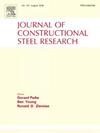Axial compression mechanical properties of UHTCC–hollow steel tube square composited short columns
IF 4
2区 工程技术
Q1 CONSTRUCTION & BUILDING TECHNOLOGY
引用次数: 0
Abstract
To investigate the mechanical properties of ultrahigh toughness cementitious composite (UHTCC)–hollow steel tube square composite short columns under axial compression, axial compression tests were conducted on 10 composite short columns organized into five distinct groups. Parameters such as the size effect and hollow ratio were used to test the variation of ultimate load and ultimate strength. The interface microstructure was characterized through scanning electron microscopy and X-ray powder diffraction analyses. Variations in ductility, strength, and energy dissipation coefficients were assessed with respect to the selected parameters. A stress–strain constitutive model for the composite short columns was formulated. Furthermore, a finite element model was constructed using the ABAQUS software suite, and the simulation results were subsequently compared against the experimental findings. A design method for the ultimate load-carrying capacity of composite short columns was also developed. Experimental outcomes, coupled with microstructural analysis, indicated that under axial compression, the components exhibited effective collaborative deformation capacity. The load-bearing capacity of composite short columns increases with their increasing size, whereas their strength decreases with increasing size. The size effect exhibited a substantial impact on the strength, energy dissipation, and ductility coefficients, whereas the hollow ratio had a comparatively minor effect. The constitutive model demonstrated strong alignment with the experimental values. The effective constraint coefficient was derived by dividing the effective controlling area, which led to a calculation formula for determining the ultimate load-carrying capacity of a composite short column under axial compression. The experimental, simulated, and theoretical values exhibited a high degree of consistency.
求助全文
约1分钟内获得全文
求助全文
来源期刊

Journal of Constructional Steel Research
工程技术-工程:土木
CiteScore
7.90
自引率
19.50%
发文量
550
审稿时长
46 days
期刊介绍:
The Journal of Constructional Steel Research provides an international forum for the presentation and discussion of the latest developments in structural steel research and their applications. It is aimed not only at researchers but also at those likely to be most affected by research results, i.e. designers and fabricators. Original papers of a high standard dealing with all aspects of steel research including theoretical and experimental research on elements, assemblages, connection and material properties are considered for publication.
 求助内容:
求助内容: 应助结果提醒方式:
应助结果提醒方式:


